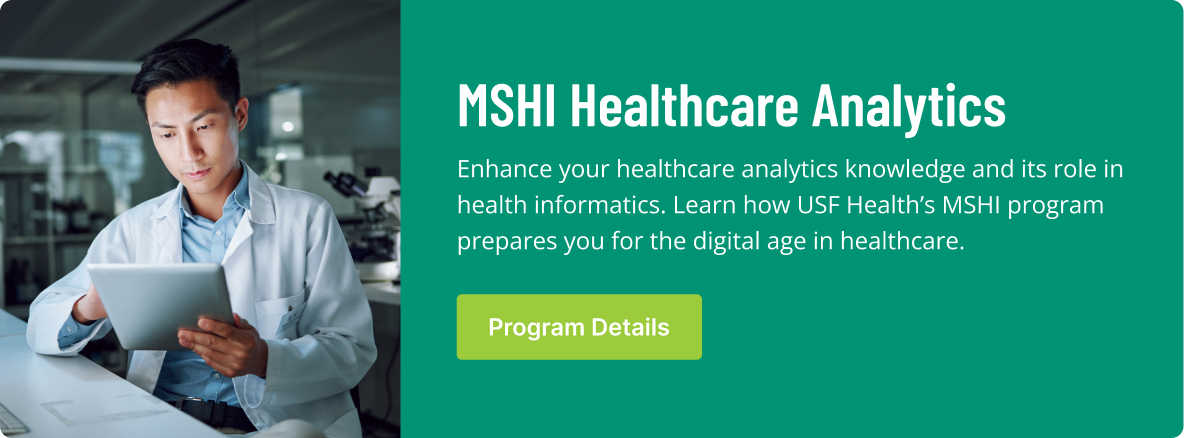The field of data analytics is evolving quickly alongside telehealth services and digitization of healthcare. Healthcare organizations make use of three main types of analytics: descriptive, predictive and prescriptive. How do these organizations use predictive analytics?
Predictive analytics compiles a broad range of detailed data throughout an organization’s different departments. The data is then processed by algorithms that recognize trends and create patterns to establish a baseline for future analysis and problem-solving efforts.
What is Predictive Analytics?
Where descriptive analytics is designed for analysis of current conditions, predictive analytics is strictly for making predictions based on historical data. Prescriptive analytics takes it further, making recommendations based on the predicted outcome. In healthcare, predictive analytics is used in a variety of ways, with commons goals focused on improving patient care and organizational efficiency. Some uses for predictive analytics include:
- Predicting potential shortages of medical supplies for different departments.
- Identifying patients who are likely to develop a chronic condition like diabetes or heart disease.
- Predicting which patients will be readmitted to the hospital after discharge.
Predictive data analysis may also enable organizations to model outcomes and impact of different organizational decisions. Proper use of predictive analytics in healthcare has significant implications for improving care quality, reducing costs and improving patient satisfaction.
Predictive Analytics and Patient Care
Hospitals can leverage insights using predictive analytics to improve patient care and efficiency in treatment. In today’s digital world, healthcare organizations rely on electronic medical record systems (EMRs) and electronic health records (EHRs) to provide clinical decision support for healthcare professionals.
These records also help improve efficiency and quality of care for patients, as they contain pertinent information about the person and the details of treatment plans and medication. Predictive analytics, in combination with systems like EMRs, EHRs, and inventory management systems, may help with:
- Keeping all healthcare professionals on the same page for a patient’s treatment.
- Reducing errors in treatments.
- Predicting medication needs and potential supply issues.
- Improving staff scheduling to meet expected activity and demand in clinics.
Predictive Analytics and the Supply Chain
The medical supply chain is a complex system with a large variety and number of stakeholders including manufacturers, distributors, hospitals, practitioners, retail businesses and health systems.
Shortages or delays in the supply chain may result from:
- Aging infrastructure (e.g., roadways, bridges).
- Unpredictable weather events or natural disasters.
- Terrorist attacks and other man-made threats.
- Ineffective communication between stakeholders.
- Personnel or resource shortages.
Predictive analytics can help organizations anticipate obstacles like the above before they occur, giving appropriate leadership time to take steps to mitigate or even avoid the situation altogether.
Predictive Analytics for Inventory Management
A critical piece of patient care is the smooth operations of healthcare organizations’ inventories. Inventory data is collected from all relevant departments and sources and then combined with current data from external stakeholders regarding existing stock levels, expected demand and potential supply chain issues.
Effective use of predictive analytics may allow organizations to:
- Minimize waste by avoiding overstocking supplies.
- Plan for potential shortages.
- Identify opportunities to improve efficiency and reduce costs through process improvements.
- Optimize staff schedules.
Effective Implementation of Predictive Analytics
Organizations seeking to utilize data effectively should conduct a thorough analysis of its current capabilities, resources and needs. The evaluation requires a cross-functional lens and may include departments such as information technology (IT) and clinical and administrative staff.
Some aspects of the organization to consider include both software and hardware available to support data use and analytics, and the skills and knowledge of the staff. Ideally, the staff includes professionals who specialize in data analytics alongside health IT.
Professionals who choose to further their education with a CAHIIM accredited MSHI Healthcare Analytics degree at an institution like USF Health may fill the critical staffing needs for effective implementation of data analytics and related technology.




